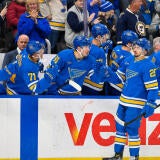How the Dion Phaneuf trade impacts the Maple Leafs' Stamkos pursuit
The Toronto Maple Leafs' trade of Dion Phaneuf cleared a lot of salary cap space in the future. Salary cap space that could go to Steven Stamkos if he becomes a free agent.

When looking at the Toronto Maple Leafs blockbuster trade of Dion Phaneuf to the Ottawa Senators, the names involved in the trade itself don't really matter all that much.
Sure, there is a chance that Jared Cowen might benefit from a chance of scenery and reach his potential. The prospect in the deal, Tobias Lindberg, seems to have some upside and a second-round pick in 2017 is a fine lottery ticket that could result in a payoff. But for the most part, the players themselves are nothing more than short-term roster-filler (much like the majority of the roster the Maple Leafs are putting on the ice this season).
They will either be flipped again by the Maple Leafs in future trades, or play out their remaining contracts and walk away as free agents.
The key to this trade for the Maple Leafs is money. It is about future salary cap space. With this deal, where they did not have to retain any of Phaneuf's remaining salary (as they had to do in the Phil Kessel trade), the Maple Leafs cleared a whole bunch of it over the next five years.
General manager Lou Lamoriello pretty much admitted all of that during a conference call on Tuesday when discussing the trade.
"This was a transaction that certainly was not for today," Lamoriello said.
"The length of Dion's contract and the amount of cap space that is now there, and where that would put us at a given time, this gives us the opportunity to do things."
But what exactly are those ... "things."

Ah, yes. There it is. The obvious answer here that everybody is going to talk about, of course, is Steven Stamkos.
With Stamkos now in the final year of his current contract with the Tampa Bay Lightning, this trade and newfound cap space for the Maple Leafs will only increase the Stamkos-to-Toronto talk that has been brewing all season (with a little unintentional help from Stamkos himself).
Really, it is all starting to fit together perfectly.
Stamkos is from the Toronto area, he is one of the best players in the NHL and when you combine his production and the fact he is only 26 years old he would be one of the top free agents to ever hit the open market if it reaches that point. Players like this do not come available very often, and the Maple Leafs could be putting themselves in a better position to go after him than any other team to go after him if he happens to hit the open market in July.
And the Phaneuf trade certainly helps.
Let's break it down.
1) The Maple Leafs pretty much had to get away from Phaneuf's contract
As the captain of the Maple Leafs, one of the highest paid players in the league, and the top defenseman on a consistently bad defensive team, Phaneuf was always going to be the target for criticism when things went poorly. And they almost always did in Toronto. Most if it was out of his control. It's not his fault the Maple Leafs failed to build around him and were putting him in a position where he had to be something he wasn't.
But let's be very clear about something here: Phaneuf is still a good NHL defenseman. In the right role can still be very productive and a useful asset to a team. He's just not a $7 million per year player that should be the go-to-guy for a team.
Good player. Bad contract. That created a lot of problems for the Maple Leafs.
He is going to turn 31 later this year, and was never going to play at a level that would justify the $35 million they still owed him over the next five years after this one. The contract was already too much, and he is only likely to continue to decline as he ages.
Even if there wasn't the possibility of making a run at the rare franchise player in free agency it was a deal they had to get away from because it was only going to become a bigger albatross on their cap situation and would continue to limit their ability to add better players.
Having said that...
2) The Maple Leafs don't save anything yet from this trade ... yet
The funny thing about this salary dump trade for the Leafs is it actually adds to their cap space for next season. At least for now.
Phaneuf's cap hit for next season was going to be $7 million, but the combined salaries of Cowen, Colin Greening and Milan Michalek take up close to $10 million. The key, though, is that the every single one of those new contracts comes off the books entirely after next season as all will be free agents at that point. And that is assuming they don't flip any of them before their contracts expire.
That means the Maple Leafs went from having $7 million per year between 2017-18 and 2020-21 going to Phaneuf, a player that was probably going to continue to decline and be a bigger and bigger drain on their salary cap, to having a completely clean slate to work with.
The reason the small increase doesn't hurt them next season is because they have so many other contracts coming off the books and will have a wave of rookies that could be ready to enter the NHL on cheap entry level deals (William Nylander, Mitch Marner, and Kasperi Kapenen just to name a few). And there is always the possibility that the lottery balls go their way for the June draft where Auston Matthews, Patrik Laine and Jesse Puljujarvi are lurking.
They also have other contracts that can buried on LTIR (Nathan Horton) and probably still have a few more trades to pull off before the deadline later this month.
When you add all of that to their ability to shed the contracts of Kessel and David Clarkson over the past two years, they have almost completely cleared the decks from pretty much all of their long-term commitments. Combined with the fact the organization is pretty much a factory that prints money, they are now a player for just about any top free agent that hits the market.
3) The money is there, but it's going to take more than that to get Stamkos
The only thing that can potentially make all of this for nothing: Stamkos has to actually be available, and has to actually want to play in Toronto.
It's one thing for the Maple Leafs to have an interest in Stamkos and to put themselves in a position to go after him in the event he is available. It is another thing entirely for Stamkos to share the same common goal.
If his Twitter habits are any indication, he might (or he is just an expert troll). But Stamkos is in a pretty good situation right now in Tampa Bay. He plays on a great team that was just in the Stanley Cup Final a year ago and, now that it is healthy this season, is starting to play at that level again.
He also doesn't have to deal with the 24/7 madness that comes from being a hockey player in Canada (just look at what's happening to him in Montreal as a visiting player!). If winning a Stanley Cup is his No. 1 priority he is going to have a much better opportunity to do that in Tampa Bay in the immediate future than he is in Toronto (while still making top dollar) a team that has completely gutted itself over the years is in a complete rebuild mode.
In Tampa Bay, he is pretty much guaranteed to be a part of a contender for the foreseeable future. In Toronto, he would be taking a gamble. A big gamble. He would be gambling that the prospects and draft picks are going to develop as expected. That the team is going to make the right decisions when it comes to adding the right pieces. And even if all of that does work out as planned, it's still probably going to be a couple of years away from being a serious Stanley Cup threat.
Until Stamkos actually signs an extension with the Lightning (or signs elsewhere as a free agent) he is going to constantly be connected to the Maple Leafs. Tuesday's trade of Phaneuf and the salary cap space it will create in future years will only increase that chatter.

















